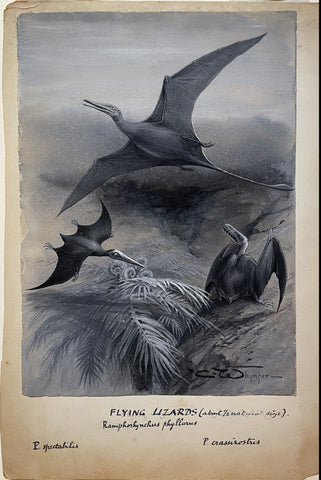
Charles Whymper (1853-1941), Flying Lizards
Charles Whymper (1853-1941)
Flying Lizards
Original Illustration in pen, ink and grey wash, heightened in white
c. 1905-1912
9 7/8 x 7 in. sheet
1. Rhamphorhynchus, “beak snout”, is a genus of long-tailed pterosaurs that lived during the Jurassic period. It had a long tail stiffened with ligaments, which ended in a characteristic soft-tissue tail vane. The jaws of Rhamphorhynchus housed needle-like teeth, which were angled forward with a curved, sharp, beak-like tip lacking teeth, indicating a diet mainly of fish; indeed, fish and cephalopod remains are frequently found in Rhamphorhynchus abdominal contents. Although fragmentary fossil remains of the Rhamphorhynchus have been found in England, Tanzania, and Spain, the best preserved specimens come from the Solnhofen limestone of Bavaria, Germany.
2. Pterodactylus (from the Greek, pterodaktulos, meaning “winged finger”) is an extinct genus of pterosaurs, whose members are commonly known as ‘pterodactyls’. It is thought to contain only a single species, Pterodactylus antiquus, which was the first pterosaur to be named and identified as a flying reptile. Fossilized remains of this Late Jurassic, carnivorous reptile have been discovered in Europe and in Africa, and the first example was discovered in Germany during the mid 18th century. The Pterodactylus wing-span was nearly 5 feet in length.
3. Scaphognathus was a pterosaur that lived around Germany during the Late Jurassic period and had a wingspan of nearly three feet. The first known Scaphognathus specimen was described in 1831 by August Goldfuss who mistook the tailless specimen for a new Pterodactylus species: P. crassirostris (as so named in this example), translating roughly as “fat snout” from Latin.
CHARLES WHYMPER (1853-1941)
Charles H. Whymper (31 August 1853 - 25 April 1941), aka C. Whymper, was a British painter and illustrator. He was born in London. His father, Josiah Wood Whymper (1813-1903), was a well-known painter and engraver. Whymper was educated at the Royal Academy Schools. He exhibited at the Royal Academy, Royal Society of British Artists, Royal Institute of Painters in Watercolors, the New Gallery, and the Fine Art Society, London. In 1909, Whymper was elected to the Royal Institute of Painters in Watercolors. Whymper was a prolific book illustrator specializing in travel, animal, and hunting themes. He also contributed to The Illustrated London News, Good Words, and The English Illustrated Magazine.
ORIGINAL WATERCOLORS PREPARED FOR HENRY KNIPE’S
NEBULA TO MAN (1905) & EVOLUTION IN THE PAST (1911-1912)
An exceedingly rare collection of original watercolors prepared for Henry Knipe’s Nebula to Man (1905) and Evolution in the Past (1911-1912) by naturalist-artists Alice Woodward, Josef Smit, and Charles Whymper.
Drawings prepared for Knipe’s Nebula to Man (1905) contributed to one of the most important publications on dinosaurs on the heels of the Great Dinosaur Rush or Bone Wars. The Bone Wars occurred between 1877 and 1892 between Edward Drinker Cope, the Academy of Natural Sciences Philadelphia, and Othniel Charles Marsh, the Peabody Museum of Natural History at Yale. These early paleontologists fought ruthlessly to pursue dinosaur fossils, a quest that resulted in an extraordinary period of discovery and the eventual financial ruin of both scientists. Their findings resulted in unearthing 136 new dinosaur species, ushering in a new paleontological research era.
According to Henry Knipe’s obituary, he worked for the British Museum. It was there that he likely met the artists tapped for this project. Knipe chose each illustrator for their reputation for scientific authenticity—namely, those skilled as bird artists, given the many similarities between bird species and dinosaurs.
We Also Recommend

![Albertus Seba (1665-1736) Tab I [Insects]](http://aradergalleries.com/cdn/shop/products/I_large.jpg?v=1635434052)
![Albertus Seba (1665-1736) Tab II [Insects]](http://aradergalleries.com/cdn/shop/products/II_large.jpg?v=1635434726)
![Albertus Seba (1665-1736) Tab III [Insects]](http://aradergalleries.com/cdn/shop/products/III_large.jpg?v=1635434877)
![Albertus Seba (1665-1736) Tab L [Insects]](http://aradergalleries.com/cdn/shop/products/L_b_large.jpg?v=1635435506)
![Albertus Seba (1665-1736) Tab L [Insects]](http://aradergalleries.com/cdn/shop/products/L_large.jpg?v=1635437893)